
Oman, officially the Sultanate of Oman, is an Arab country on the southeastern coast of the Arabian Peninsula in Western Asia. Located in a strategically important position at the mouth of the Persian Gulf, the country shares land borders with the United Arab Emirates to the northwest, Saudi Arabia to the west, and Yemen to the southwest, and shares marine borders with Iran and Pakistan. The coast is formed by the Arabian Sea on the southeast and the Gulf of Oman on the northeast. The Madha and Musandam exclaves are surrounded by the UAE on their land borders, with the Strait of Hormuz and the Gulf of Oman forming Musandam's coastal boundaries.
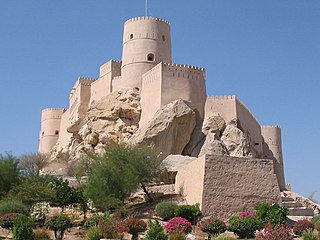
Oman is the site of pre-historic human habitation, stretching back over 100,000 years. The region was impacted by powerful invaders, including other Arab tribes, Portugal and Britain. Oman once possessed the island of Zanzibar, on the east coast of Africa as a colony.
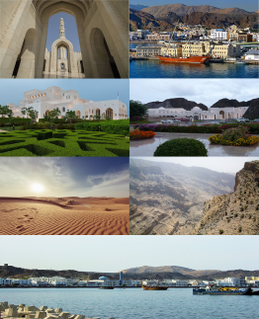
Muscat is the capital and largest city of Oman. It is the seat of the Governorate of Muscat. According to the National Centre for Statistics and Information (NCSI), the total population of Muscat Governorate reached 1.4 million as of September 2018. The metropolitan area spans approximately 3,500 km2 (1,400 sq mi) and includes six provinces called wilayat. Known since the early 1st century CE as an important trading port between the west and the east, Muscat was ruled by various indigenous tribes as well as foreign powers such as the Persians, the Portuguese Empire, the Iberian Union and the Ottoman Empire at various points in its history. A regional military power in the 18th century, Muscat's influence extended as far as East Africa and Zanzibar. As an important port-town in the Gulf of Oman, Muscat attracted foreign tradesmen and settlers such as the Persians and the Balochis. Since the ascension of Qaboos bin Said as Sultan of Oman in 1970, Muscat has experienced rapid infrastructural development that has led to the growth of a vibrant economy and a multi-ethnic society. Muscat is termed as a Global City.

Said bin Taimur was the 13th Sultan of Muscat and Oman from 10 February 1932 until he was deposed on 23 July 1970 by his son Qaboos bin Said.

Qaboos bin Said was the Sultan of Oman from 23 July 1970 until his death. A fifteenth-generation descendant of the founder of the House of Al Said, he was the longest-serving leader in the Middle East and Arab world at the time of his death.
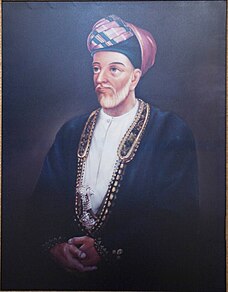
Said bin Sultan Al-Said was Sultan of Muscat and Oman from 1806 to 4 June 1856.

The Sultanate of Muscat and Oman was a thalassocratic nation that encompassed the present-day Sultanate of Oman and parts of present-day United Arab Emirates and Gwadar, Pakistan. The country is not to be confused with the Trucial States, which were sheikhdoms under British protection since 1820. Muscat courts' verdicts were based on Ibadi Islamic sharia law and appeals were raised to the Sultan of Muscat, who exercised supreme ruling.

Bandar Jissah is a coastal town in northeastern Oman.

Oman proper may refer to Al Hajar Mountains, and the Imamate of Oman refers to a historical area within the present-day Sultanate of Oman. The capital of the Imamate alternated historically between Rustaq and Nizwa. The Imamate's territory extended north to Ibri and south to Alsharqiyah region and the Sharqiya Sands. The Imamate was bounded from the east by the Al Hajar Mountains and from the west by the Rub' al Khali desert. The Al Hajar Mountains separated the Imamate of Oman from the Sultanate of Muscat. The elected Imam (ruler) resided in the capital, and Walis (governors) represented the Imamate in its different regions.

The Treaty of Seeb was an agreement reached between the sultan of Muscat, Taimur bin Feisal, and the Imamate of Oman on 25 September 1920. The treaty granted autonomy to the imamate in the interior of Oman but recognized the sovereignty of the Sultanate of Muscat. The treaty was named after Seeb (as-Sib), a coastal town in present-day Oman.

This page list topics related to Oman.

The House of Al Said is the ruling royal house of the Sultanate of Oman, and former ruling royal house of the Sultanate of Muscat and Zanzibar and the Sultanate of Zanzibar.
The Oman Children's Museum is a children's science museum, located near Qurum Nature Park off Sultan Qaboos Street in a white-domed building in Muscat, Oman.

Al Jalali Fort, or Ash Sharqiya Fort, is a fort in the harbor of Old Muscat, Oman. The fort was built by the Portuguese under Philip I of Portugal in the 1580s to protect the harbor after Muscat had twice been sacked by Ottoman forces. It fell to Omani forces in 1650. During the civil wars between 1718 and 1747, the fort was twice captured by Persians who had been invited to assist one of the rival Imams. The fort was extensively rebuilt later.
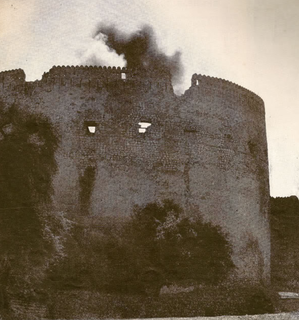
The Jebel Akhdar War or the Oman War, also known as Jebel Akhdar rebellion broke out in 1954 and again in 1957 in Oman, as an effort by the local Omanis in the interior of Oman led by their elected Imam, Ghalib Alhinai, to protect the Imamate of Oman from the occupation plans of sultan Said bin Taimur, backed by the British government, who were eager to gain access to the oil wells in the interior lands of Oman. Sultan Said received direct financing to raise an armed force to occupy the Imamate of Oman from Iraq Petroleum Company (IPC), a consortium of oil companies that was majorly owned by what-is-known-today as Royal Dutch Shell, Total, ExxonMobil and British Petroleum (BP); the latter was majority-owned by the British government. The Imamate was eventually supported by Arab states. The war lasted until 1959, when the British armed forces decided to take on direct interventions using air and ground attacks on the Imamate, which won the Sultanate the war. The declarations signed by the sultans of Muscat to consult the British government on all important matters, the unequal trade treaties signed by the two sides favoring British interests, the cessation of the Omani Kuria Muria islands to the British, and the vast control over the Sultanate's government ministries, including defense and foreign affairs, exerted by the British rendered the Sultanate a de facto British colony. The UN General Assembly adopted the 'Question of Oman' resolution in 1965, 1966 and again in 1967 that called upon the British government to cease all repressive action against the locals, end British control over Oman and reaffirmed the inalienable right of the Omani people to self-determination and independence.
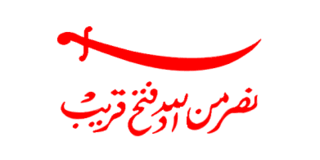
The Omani Empire was a powerful maritime empire, vying with Portugal and Britain for influence in the Persian Gulf and Indian Ocean. At its peak in the 19th century, Omani influence or control extended across the Strait of Hormuz to modern-day Iran and Pakistan, and as far south as Cape Delgado. After the death of Said bin Sultan in 1856 the empire was divided into two sultanates, an African section ruled by Majid bin Said and an Asian section ruled by Thuwaini bin Said.
Sultan bin Ahmad was the Sultan of Oman, the fourth of the Al Said dynasty, ruling the country between 1792 and 1804.
The following is a timeline of the history of the city of Muscat, Oman.

The Palace Office transliterated:maktab al qasr is one of the most senior and therefore powerful ministries in the Sultanate of Oman. It is a government body that has most influence in national security and intelligence issues and the minister in charge has been the de facto national security advisor to the Sultan. The Palace Office also acts as a foreign liaison focus on all international intelligence and security matters.















